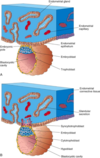Embryology Lecture 1-Intro to Embryology: Gametogenesis and Week 1 Flashcards
(57 cards)
___% - ___% of zygotes never implant by week ___
30%-50% of zygotes never implant by week 2
___% of recognized pregnancies result in miscarriage during the first ___ weeks
15% of recognized pregnancies result in miscarriage during the first 12 weeks
___% of miscarried conceptuses have _________ abnormalities
60% of miscarried conceptuses have chromosomal abnormalities
___% of neonatal deaths are attributed to congenital malformations
20% of neonatal deaths are attributed to congenital malformations
___%-___% of live births have at least one birth defect
1.5-3.5% of lie virths have at least one birth defect
___%-___% more birth defects are discovered by end of 1st year of life
3%-7% more birth defects are discovered by end of 1st year of life
Birth defects are attributed to: 10% ________ 10% ________ 80%________
Birth defects are attributed to: 10% Environment (smoking or alcohol use during pregnancy 10% Genetics 80% Gene-Environment interaction
Development Timing: Zygote
weeks 1-2
Development Timing: Embryo/Embryonic Period
week 3 to week 8, rapid organ development, brain and heart are growing really rapidly
Development Timing: Fetus/Fetal Period
week 9 to week 38 (first two weeks are from first day or last period)
Terminology for Postnatal Human vs. for Embryo:
Superior vs. _____
Anterior vs. _____
Posterior vs. _____
Inferior vs. _____
Terminology for Postnatal Human vs. for Embryo:
Superior vs. Cranial
Anterior vs. Ventral
Posterior vs. Dorsal
Inferior vs. Caudal
Define Gametogenesis
a biological process by which diploid primordial germ cells ( spermatogonium and primary oocyte) undergo cell division and differentiation (meiosis) to reduce the number of chromosomes and form mature haploid gametes.
Characteristics of Trisonomy 21
Class III skeletal phenotypes, fissured tongue, concave facial profile, high rates of malocclusion, dental anomalies including hypdontia, brusixm, low carries, high periodontal disease
Threadlike structure in the nucleus of cell, made of protein and DNA, inherited from parents
Chromosome
Each chromosome contains a number of _____
Each chromosome contains a number of genes.
Humans have ___ pairs of chromosomes. ___ autosomes and ___ sex chromosomes
Humans have 23 pairs of chromosomes. 22 autosomes (paired chromosomes, non-sex chromosomes) and 1 sex chromosome.
For sexual reproduction, a critical step in meiosis is to reduce the chromosome to a “haploid” (23 chromosomes). Why is this?
Because if you join extra information (chromosomes) it results in chromosomal abnormalities.
_______ restores the “diploid” number
Fertilization restores the “diploid” number
Define “Mitosis”
Cell division that results in two daughter cells having the same number (diploid) and kind of chromosomes as the parent nucleus
Define “Meiosis”
Cell division that results in four daughter cells each with half (haploid) the number of chromosomes of the parent cell
Name and describe this phase of Mitosis

Prophase- Homologous chromosomes pair up. Each consists of two sister chromatids.
Describe Oogenesis in sequence.
- ) In the ovaries, primary oocytes and support cells (follicle cells) form. Follicular cells encircle the primary oocyte.
- )Later during development, a glycoprotein called the zona pellucida forms covering the oocyte.
- ) Primary oocytes begin first meiotic division before birth. First meiosis is not complete until puberty. Follicular cells ensure arrest in prophase by hormonal secretion.
- ) At puberty maturation continues. Primary oocyte increases in size, follicular cells mature.
- ) Before ovulation the primary oocyte completes first meiosis giving rise to the secondary or mature oocyte.
- ) A polar body is also formed which recieves little cytoplasm and goes on to degenerate.
- ) At ovulation the secondary oocyte begins second meiosis progressing to metaphase before again halting.
- ) Second meiosis is only completed upon fertilization.

Describe Spermatogenesis in sequence.
- ) Primary germ cells transformation to mature sperm.
- ) At puberty primary spermatocytes undergo meiosis, forming two cells in first meiosis (haploid). Forming four cells in second meiosis.
- ) Spermatids then transform gradually into mature sperm by differentiation (spermiogenesis).

Define/describe spermiogenesis.
Several morphological changes occur:
- ) elongation
- ) loss of cytoplasm
- ) tail formation
- ) Acrosome develops (contains enzymes important for fertilization).




























